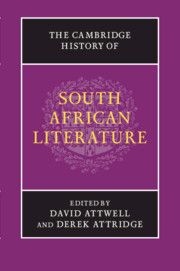Book contents
- Frontmatter
- Introduction
- PART I ORATURES, ORAL HISTORIES, ORIGINS
- PART II EXPLORATION, EARLY MODERNITY AND ENLIGHTENMENT AT THE CAPE, 1488–1820
- PART III EMPIRE, RESISTANCE AND NATIONAL BEGINNINGS, 1820–1910
- 9 Writing settlement and empire: the Cape after 1820
- 10 The mission presses and the rise of black journalism
- 11 The imperial romance
- 12 Perspectives on the South AfricanWar
- 13 The beginnings of Afrikaans literature
- PART IV MODERNISM AND TRANSNATIONAL CULTURE, 1910–1948
- PART V APARTHEID AND ITS AFTERMATH, 1948 TO THE PRESENT
- PART VI SOUTH AFRICAN LITERATURE: CONTINUITIES AND CONTRASTS
- Index
- References
13 - The beginnings of Afrikaans literature
from PART III - EMPIRE, RESISTANCE AND NATIONAL BEGINNINGS, 1820–1910
Published online by Cambridge University Press: 28 January 2012
- Frontmatter
- Introduction
- PART I ORATURES, ORAL HISTORIES, ORIGINS
- PART II EXPLORATION, EARLY MODERNITY AND ENLIGHTENMENT AT THE CAPE, 1488–1820
- PART III EMPIRE, RESISTANCE AND NATIONAL BEGINNINGS, 1820–1910
- 9 Writing settlement and empire: the Cape after 1820
- 10 The mission presses and the rise of black journalism
- 11 The imperial romance
- 12 Perspectives on the South AfricanWar
- 13 The beginnings of Afrikaans literature
- PART IV MODERNISM AND TRANSNATIONAL CULTURE, 1910–1948
- PART V APARTHEID AND ITS AFTERMATH, 1948 TO THE PRESENT
- PART VI SOUTH AFRICAN LITERATURE: CONTINUITIES AND CONTRASTS
- Index
- References
Summary
In 1975 the Afrikaans Language Monument was completed. It stands on the southern slopes of Paarl Mountain, overlooking the site where the Genootskap van Regte Afrikaners (GRA) (Association of True Afrikaners) first came together a century before to help standardise Afrikaans and to promote Afrikaans literature. It is an abstract-style monument with sharp lines designed by the architect Jan van Wijk: to the left the colonnade symbolises the languages and cultures of western Europe; encircling the front and right the podium represents Africa; and the low wall between the African and European elements symbolises the Malayan language and culture. The main column rises from the confluence of these structures and represents Afrikaans: distinct yet rooted in these diverse linguistic and cultural traditions. On its right, a column symbolising the Republic of South Africa stands free, yet remains part of the structure. As Van Wyk Louw's inscription reads:
Afrikaans is the language that connects Western Europe and Africa … It forms a bridge between the large, shining West and the magical Africa … And what great things may come from their union – that is maybe what lies a head for Afrikaans to discover. But what we must never forget, is that this change of country and landscape sharpened, kneaded and knitted this newlybecoming language … And so Afrikaans became able to speak out from this new land … Our task lies in the use that we make and will make of this gleaming vehicle.
- Type
- Chapter
- Information
- The Cambridge History of South African Literature , pp. 262 - 286Publisher: Cambridge University PressPrint publication year: 2012
References
- 1
- Cited by



